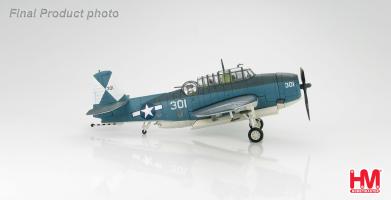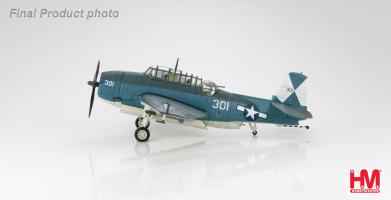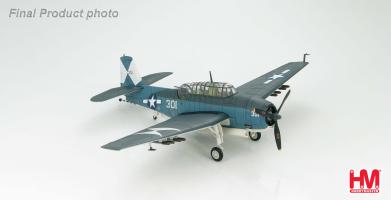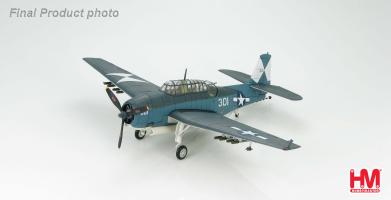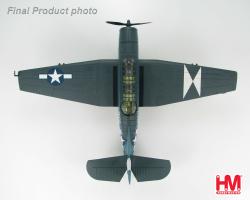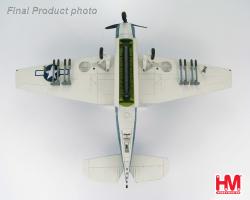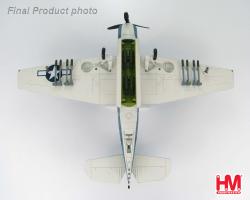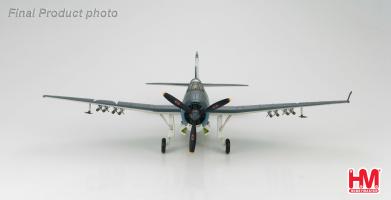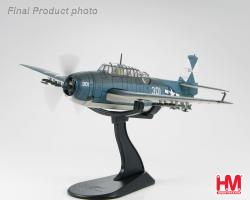Hobby Master Archive
Air Power Propellers 1/72
TBF/TBM
Grumman TBM-3 Avenger VT-83, USS Essex, April 1945
Hobby Master 1/72 Air Power Series HA1215 Grumman TBM-3 Avenger VT-83, USS Essex, April 1945
Die-cast metal. Superb detailing in 1/72 scale. Pre-painted with pad applied markings. Fully assembled. Weapons are not permanently attached Bomb bay can be displayed open or closed. Display stand included. Option to display model with wheels up or down. Minimum use of plastic. Very collectable.
Specifications for the Avenger General characteristics - Crew: 3 Dimensions - Length: 40 ft. 11.5 in. (12.48 m) Wingspan: 54 ft. 2 in. (16.51 m) Height: 15 ft. 5 in. (4.70 m) Wing area: 490.02 ft. sq. (45.52 m sq.) Weight - Empty: 10,545 lb. (4,783 kg) Loaded: 17,893 lb. (8,115 kg) Power plant: 1 Wright R-2600-20 radial engine producing 1,900 hp (1,420 kW) Performance - Maximum speed: 276 mph (444km/h) Range: 1,000 miles (1,610 km) Service ceiling: 30,100 ft (9,170 m) Rate of climb: 2,060 ft/min (10.5 m/s) Wing loading: 36.5 ft-lbf sq (178 kg/m sq) Armament - 1x 0.30 cal (7.62 mm) nose-mounted machine gun 2 x 0.50 cal (12.7 mm) wing-mounted machine guns 1 x 0.50 cal (12.7 mm) dorsal-mounted machine gun 1 x 0.30 cal (7.62 mm) ventral-mounted machine gun Up to 2,000 lb (900 kg) of bombs 1 x 2,000 lb (900 kg) torpedo
Just prior to the start of WW II the USN started to look for a replacement for their aging Douglas Devastator. Grumman made a presentation of a prototype labeled as XTBF-1 that impressed the USN and they placed an order to purchase. The plane was perfect for the Navy needs, a huge rotary engine that was enclosed in a barrel like fuselage to cut down on drag, and with some increase in the fuselage and wing lengths would accommodate a three- man crew. Production on what was now officially known as the TBF/TBM Avenger and would come to receive the affectionate name of “The Turkey” from the pilots that flew them began in 1941 with first delivery just in time for the Battle of Midway in June 1942. What started out as a carrier borne torpedo bomber soon turned into a close-support bomber, a patrol aircraft and even a trainer.
On April 7, 1945 the Japanese battleship Yamato along with 1 light-cruiser and 8 destroyers were spotted off the coast of Kyushu headed for the U.S. ships supporting the landing on Okinawa. As part of Task Force 53, Air Group 83 and others launched a full- scale assault on the Japanese Task Force. When it was over the Yamato, the 1 cruiser, 3 destroyers were sunk and the other 5 destroyers fled. It was determined that TBM’s from VT-83 scored four definite torpedo hits as well as 4 probable hits on the Yamato. They also scored 2 1,000 lb. bombs hits on the cruiser and sank 1 destroyer with a single torpedo.
| Added to archive | 2016-08-01 |
| Last modified | 2016-08-01 |
| Leaflet | 2010-11-01 November 2010 |
